Maria Theresa Worksheets
Do you want to save dozens of hours in time? Get your evenings and weekends back? Be able to teach about Maria Theresa to your students?
Our worksheet bundle includes a fact file and printable worksheets and student activities. Perfect for both the classroom and homeschooling!
Resource Examples
Click any of the example images below to view a larger version.
Fact File
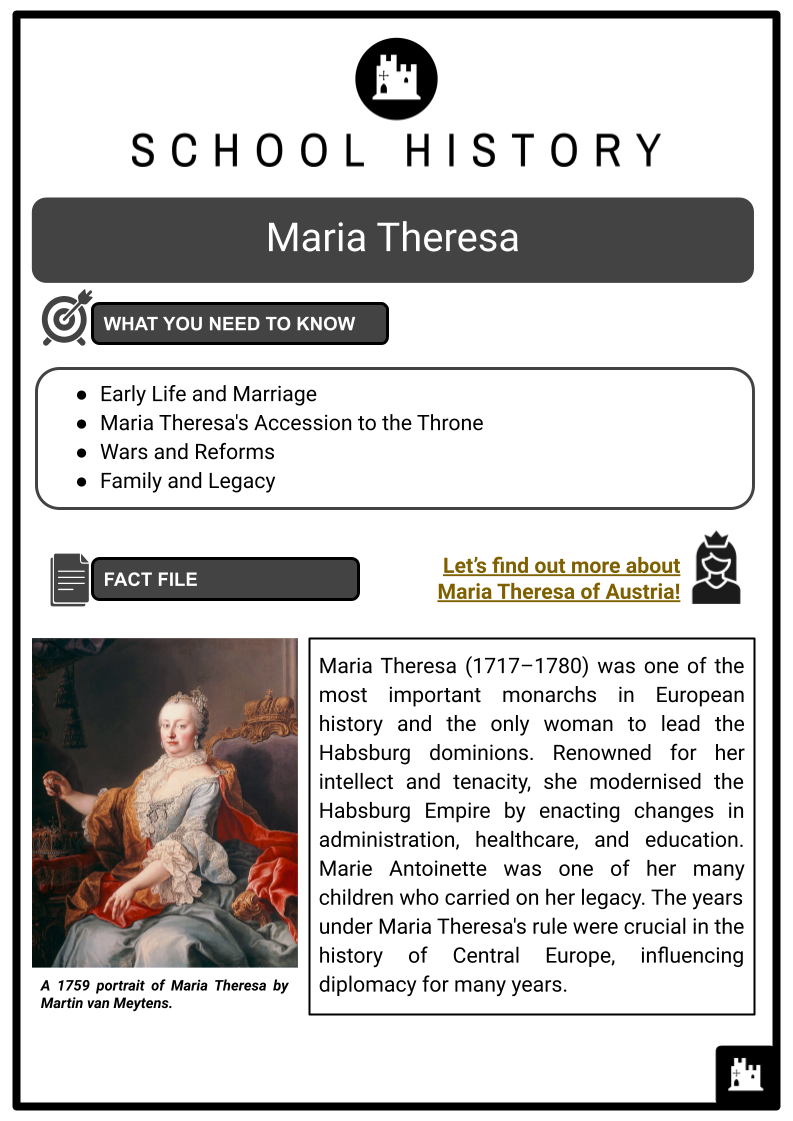
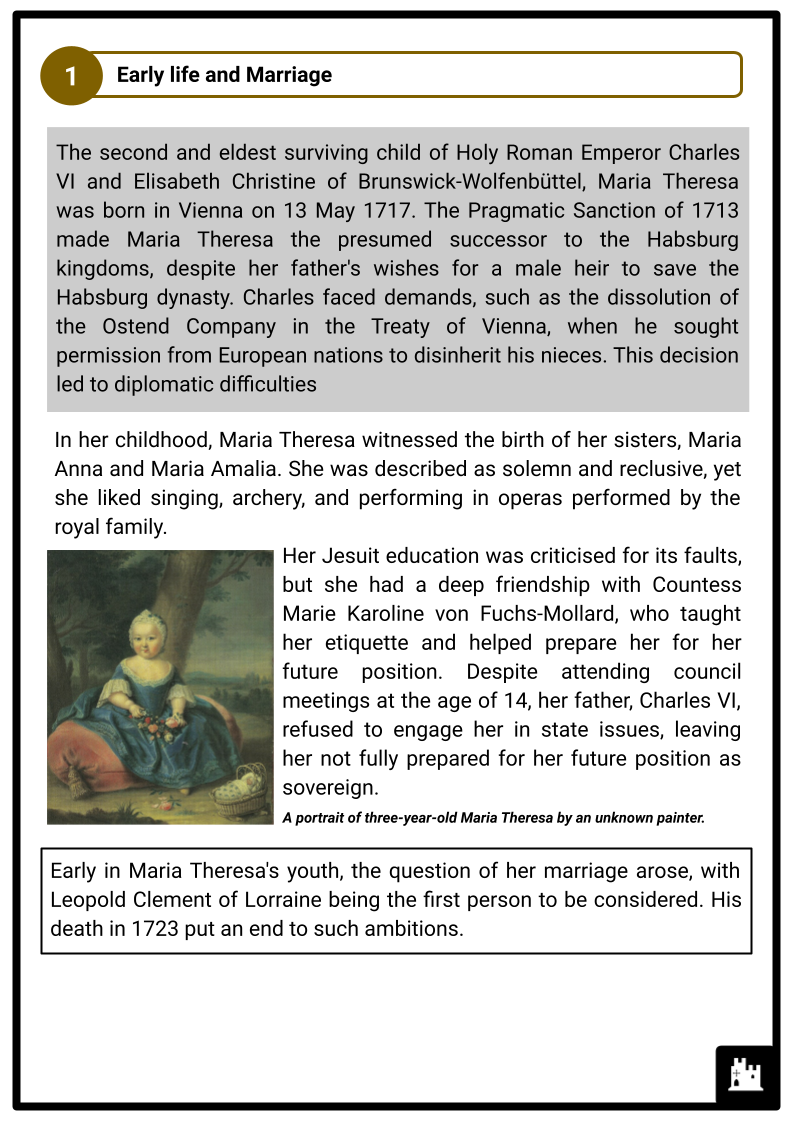
Student Activities
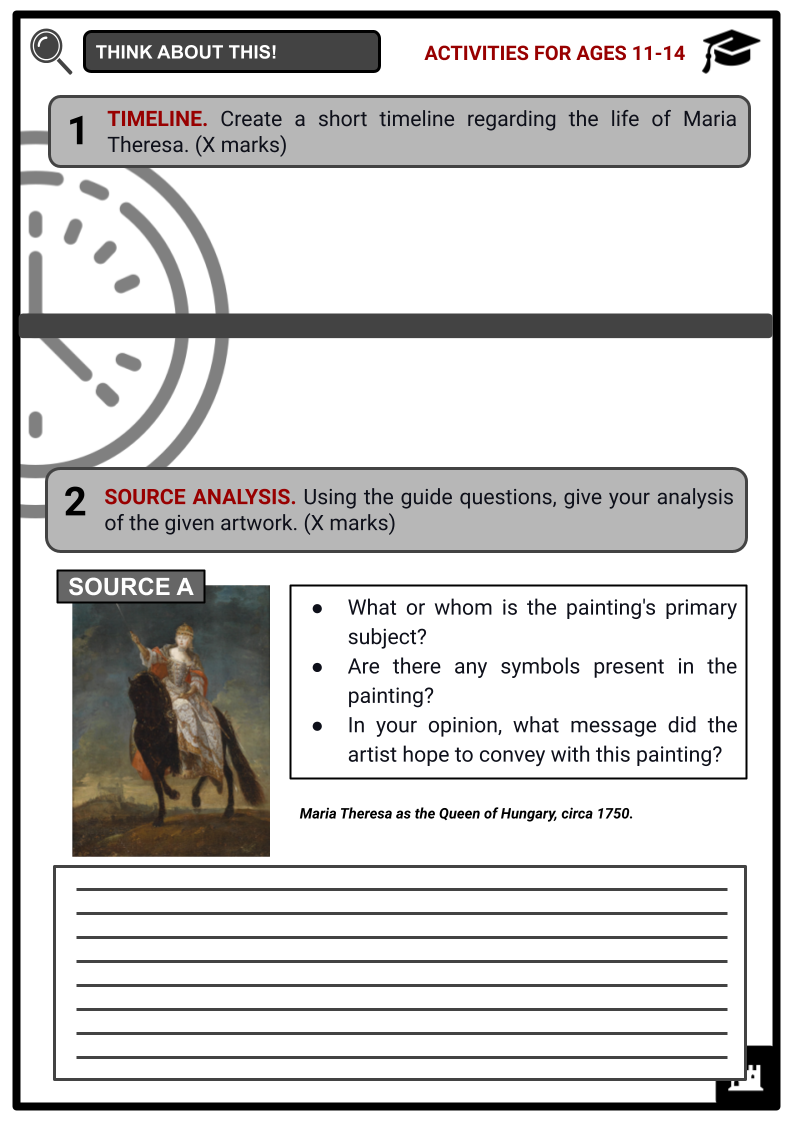
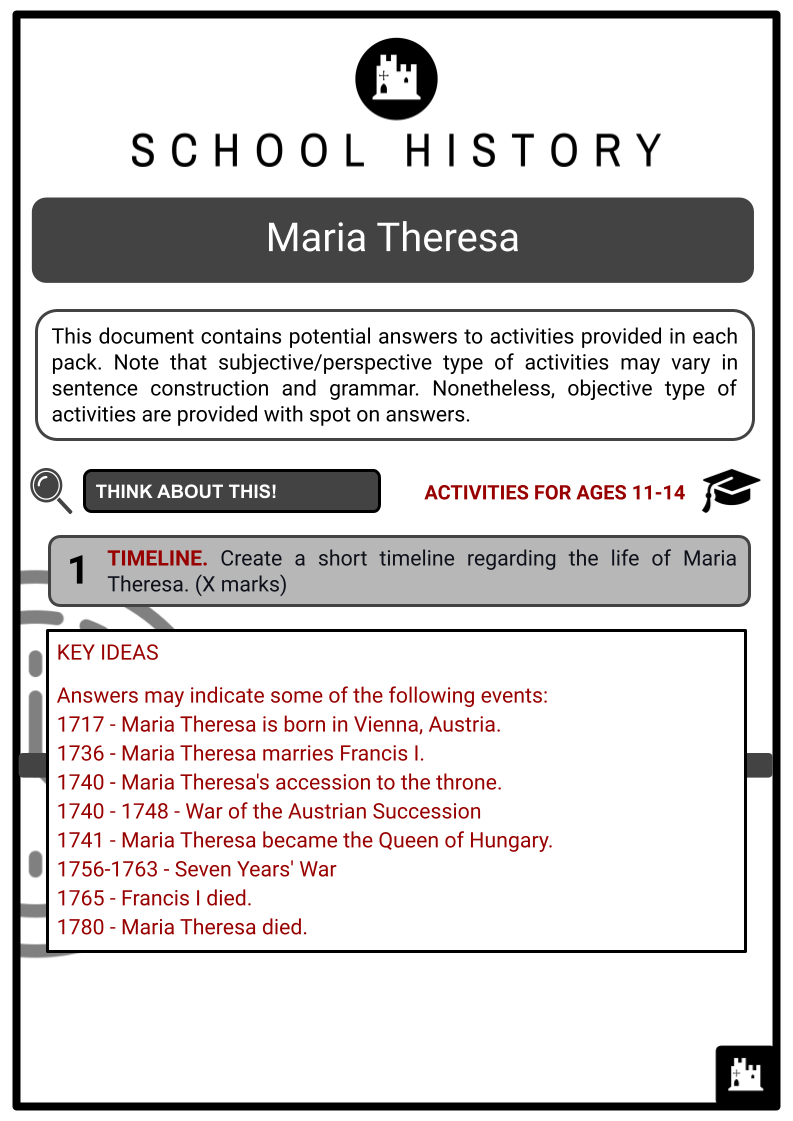
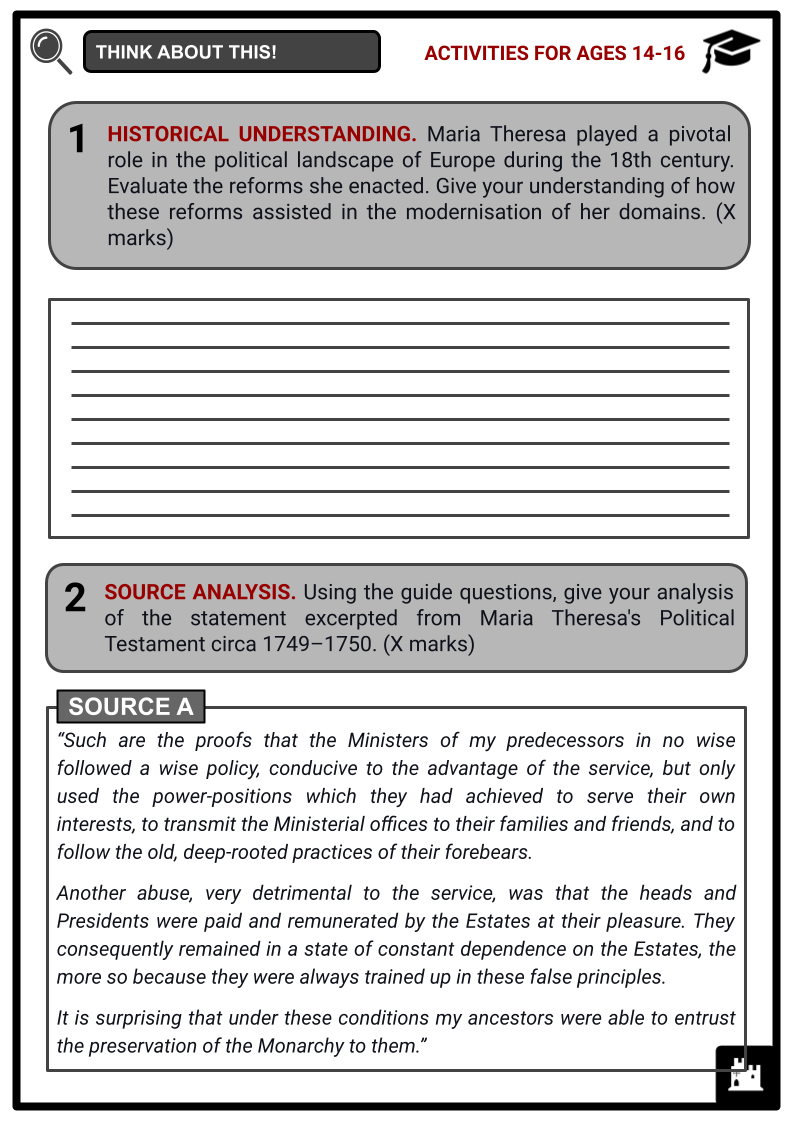
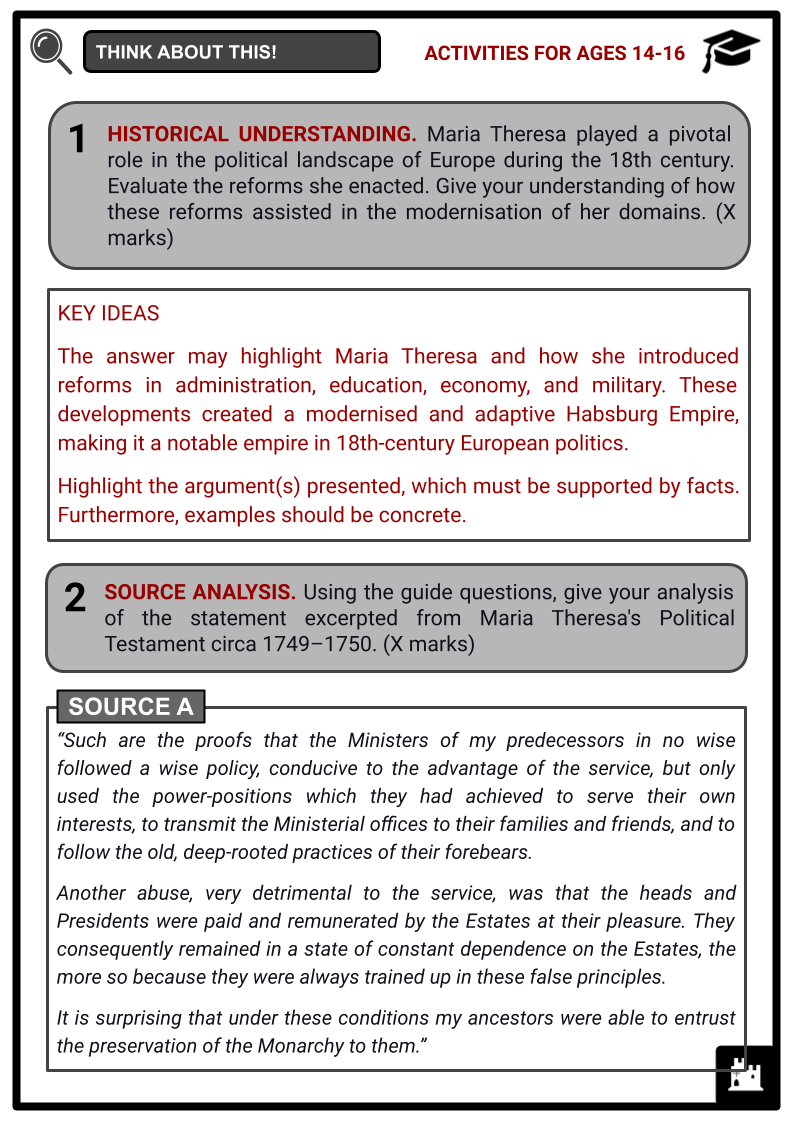
Summary
- Early Life and Marriage
- Maria Theresa's Accession to the Throne
- Wars and Reforms
- Family and Legacy
Key Facts And Information
Let’s find out more about Maria Theresa of Austria!
Maria Theresa (1717–1780) was one of the most important monarchs in European history and the only woman to lead the Habsburg dominions. Renowned for her intellect and tenacity, she modernised the Habsburg Empire by enacting changes in administration, healthcare, and education. Marie Antoinette was one of her many children who carried on her legacy. The years under Maria Theresa's rule were crucial in the history of Central Europe, influencing diplomacy for many years.
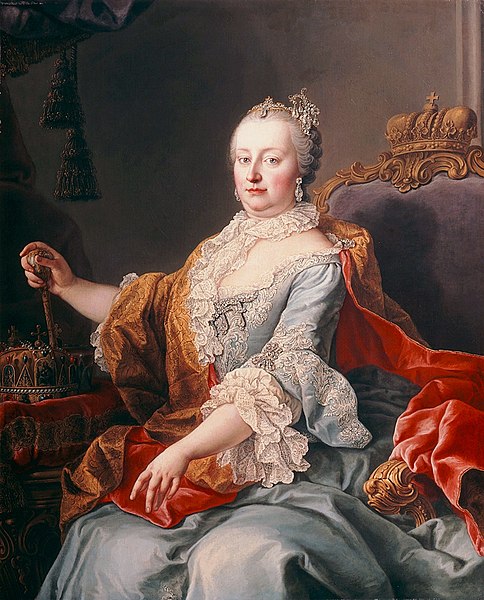
Early life and Marriage
- The second and eldest surviving child of Holy Roman Emperor Charles VI and Elisabeth Christine of Brunswick-Wolfenbüttel, Maria Theresa was born in Vienna on 13 May 1717. The Pragmatic Sanction of 1713 made Maria Theresa the presumed successor to the Habsburg kingdoms, despite her father's wishes for a male heir to save the Habsburg dynasty. Charles faced demands, such as the dissolution of the Ostend Company in the Treaty of Vienna, when he sought permission from European nations to disinherit his nieces. This decision led to diplomatic difficulties
- In her childhood, Maria Theresa witnessed the birth of her sisters, Maria Anna and Maria Amalia. She was described as solemn and reclusive, yet she liked singing, archery, and performing in operas performed by the royal family.
- Her Jesuit education was criticised for its faults, but she had a deep friendship with Countess Marie Karoline von Fuchs-Mollard, who taught her etiquette and helped prepare her for her future position. Despite attending council meetings at the age of 14, her father, Charles VI, refused to engage her in state issues, leaving her not fully prepared for her future position as sovereign.
- Early in Maria Theresa's youth, the question of her marriage arose, with Leopold Clement of Lorraine being the first person to be considered. His death in 1723 put an end to such ambitions.
- Emperor Charles VI considered various options, including a 1725 betrothal to Charles of Spain, but Francis Stephen (Francis I), the younger brother of Leopold Clement, quickly became the front-runner. Compelled by European powers, Maria Theresa's engagement to Charles was called off, allowing her to become more acquainted with Francis Stephen.
- During the War of the Polish Succession, on 31 January 1736, Maria Theresa married Francis Stephen, as per their formal agreement. There were difficulties in the marriage because of Maria Theresa's intense love for her husband, which was in stark contrast to Francis Stephen's. Jealousy was a significant issue that arose, as Francis Stephen's adultery, particularly with Maria Wilhelmina, Princess of Auersperg.
Maria Theresa's Accession to the Throne
- On 20 October 1740, Holy Roman Emperor Charles VI died probably due to mushroom poisoning. During the latter part of his reign, Austria was left with reduced finances, a crippled military, and a poorly trained force.
- After her accession, Maria Theresa encountered challenges. She originally depended on her husband, Francis Stephen, and her father's ministers, oblivious to state concerns and their failings. Both choices were regrettable. Maria Theresa lacked money, credit, an army, and expert counsel. She wrote in her Political Testament about her lack of money and support.
- Maria Theresa quickly secured imperial dignity to avoid territorial seizures by neighbouring nations. Her sex prevented her from becoming the Holy Roman Empress; rather, she pursued Francis Stephen's office.
- On 21 November 1740, Maria Theresa appointed Francis Stephen, co-ruler of Austria and Bohemia, to make him eligible for the imperial throne and imperial elections as King of Bohemia. The Diet of Hungary delayed nearly a year to ratify this arrangement because they stated Hungary's sovereignty could not be shared.
- Maria Theresa never let Francis Stephen decide state decisions, despite her affection for him and his co-rulership. She routinely expelled him from council meetings for opposing points. On 22 November 1740, the Lower Austrian Estates paid Maria Theresa homage, her first public act of authority. This elaborate event legitimised her accession, with the Hofburg Ritterstube oath of fealty taken the same day.
Wars and Reforms
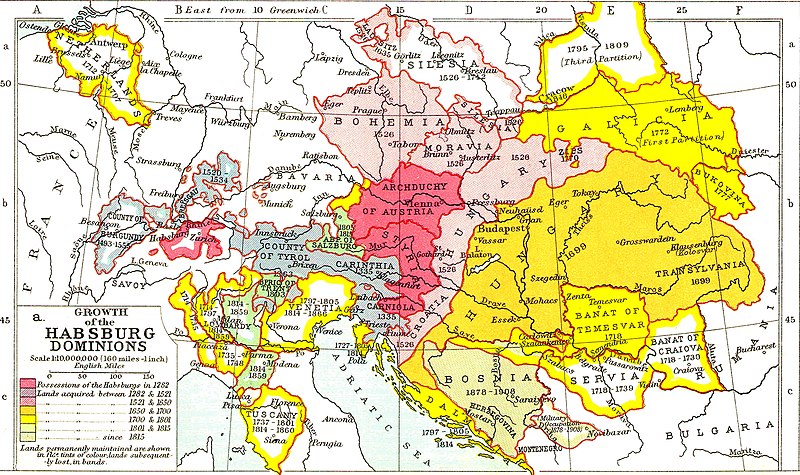
War of the Austrian Succession
- Queen Elizabeth of Spain and Elector Charles Albert of Bavaria breached their agreements to accept Maria Theresa as successor after her accession.
- Frederick II of Prussia attacked Silesia in December, threatening Maria Theresa to cede. The First Silesian War began when she fought for the mineral-rich area.
- Austria lost the First Silesian War to Prussia at Mollwitz. France suggested partitioning Austria among Prussia, Bavaria, Saxony, and Spain.
- Hungary backed Maria Theresa despite losses. In 1741, she became Queen of Hungary with masculine titles, showing her drive and skill to win support.
- Maria Theresa faced Polish and Hanoverian challenges. Her conciliation efforts failed; therefore, she sought Hungarian troops. Her passionate appeal to the Hungarian Diet stressed Hungary's danger and her commitment to defend her land.
- Maria Theresa lost Bohemia to Charles Albert, the Bavarian Elector. Charles VII was elected Holy Roman Emperor in 1742. Maria Theresa, deeming it a disaster, retook Munich in the winter.
- The war between Austria and Prussia ended in June 1742 with the Treaty of Breslau. Maria Theresa was crowned Queen of Bohemia in St. Vitus Cathedral in 1743 for her efforts to restore Bohemia. In response to Austrian advances, Prussia started the Second Silesian War.
- In 1745, Francis Stephen became the Holy Roman Emperor. The war continued until December 1745, when the Treaty of Dresden recognised Prussia's Silesia.
- The war lasted three more years in northern Italy and the Austrian Netherlands. Prussia gained Silesia, and Maria Theresa lost Parma to Philip of Spain at the Treaty of Aix-la-Chapelle. France returned to the Austrian Netherlands to prevent conflicts, and Austria retained key possessions.
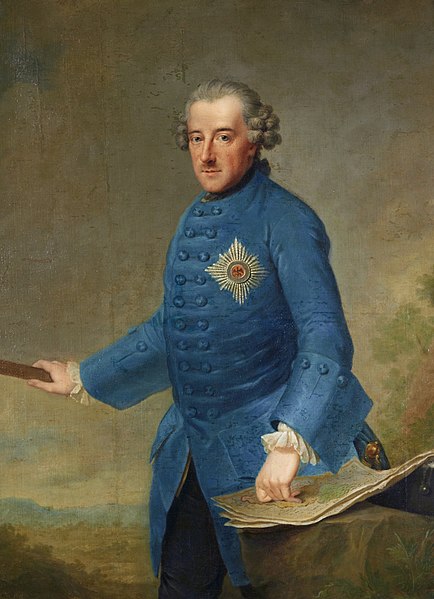
Seven Years' War
- In August 1756, Frederick II of Prussia invaded Saxony, starting the Third Silesian War and the Seven Years' War.
- Maria Theresa and Prince Kaunitz wanted Silesia to end the war. Former ambassador to Versailles Kaunitz negotiated the First Treaty of Versailles (1756), uniting Austria and France against Prussia.
- In the Second Treaty of Versailles (1757), Louis XV promised Austria military troops and annual financial aid. In exchange, Austria ceded villages in the Austrian Netherlands to Louis XV's son-in-law, Philip of Parma.
- After Maximilian von Browne, Prince Charles Alexander of Lorraine, Leopold Joseph von Daun, Franz Moritz von Lacy, and Ernst Gideon von Laudon led the Austrian troops. Despite Charles Alexander's incompetence, successive leaders won triumphs, such as the Battle of Kolin.
- Prussia lost Hochkirch, Kunersdorf, and Landeshut. Even the Austrian and Russian armies invaded Berlin. Frederick's successes at Rossbach and Torgau, Elizabeth's death in 1762, and reduced French financing transformed the conflict.
- The Treaty of Hubertusburg and Paris (1763) ended the war, with Austria leaving Prussia. Austria benefited from a new European balance of power and Bourbon ties, even while Silesia remained under Prussian rule. After the conflict, Maria Theresa prioritised internal reforms over military actions, changing her strategic priorities.
Reforms
Religion
- Maria Theresa, a fervent Roman Catholic and Habsburg, opposed religious toleration and valued religious unity for public peace. Despite criticism for her regime's bigotry and intolerance, she selected archbishops, bishops, and abbots and kept Rome away to defend the monarch's prerogatives. She promoted national church freedom from Rome under the influence of Jansenist ideals, in keeping with Austria's history of state control in church-state relations.
- Maria Theresa championed Greek Catholics as equals to Latin Catholics. Despite her religiosity, she banned public flagellants to suppress religious zeal. She also cut religious feasts and monastic orders.
Health
- Under her rule, Maria Theresa improved public health and safety. She founded the Viennese Medicine School and improved hygiene after hiring Gerard van Swieten. She overcame scepticism to advocate immunisation during the 1767 smallpox pandemic. Maria Theresa and two of her children were inoculated after a successful experiment. She hosted gatherings to promote inoculation and change Austrian doctors' views.
- Maria Theresa regulated poison sales in 1770 for public safety. Pharmacists had to keep a poison registry, and buyers needed two character witnesses. She also banned lead in eating and drinking vessels, permitting only pure tin. She supported Austrian public health and safety objectives with these methods.
Military and Bureaucracy
- Although conservative in state and religion, Maria Theresa made major military and bureaucratic changes to improve Austria. Friedrich Wilhelm von Haugwitz led a 108,000-man army supported by the aristocracy and crown land taxes. In 1749, the Directory brought significant centralisation to public institutions. This reform had little effect on Lombardy, the Austrian Netherlands, and Hungary due to their privileges, but after Silesia was lost, the governing system changed.
- The Directory became the United Austrian and Bohemian Chancellery in 1761, with independent courts and finances. Maria Theresa reestablished the Hofkammer in 1762, a financial ministry that controlled monarchy revenues.
- In 1760, the state chancellor, nobility, and knights founded the Council of State, an advisory group that contrasted with Frederick II of Prussia's dictatorial authority. Maria Theresa's financial measures, including taxing clergy and nobles, increased state revenue from 20 to 40 million florins between 1754 and 1764.
Economy
- Maria Theresa believed that peasants' well-being, productivity, and state revenue were connected hence, she sought to raise the living standards. She imposed subsidies, trade barriers, and industrial strengthening after losing Silesia. Bohemia, Moravia, Hungary, and Galicia saw serfdom reforms.
- The 1770–71 census revealed terrible peasant forced labour, spurring change. Decrees such as "Robot Patents" (1771–1778) wherein forced labour of serfs was regulated, promoted rural self-sufficiency and national spending. She started the "Raabisation" effort in 1773, breaking huge estates into small farms, transforming compulsory labour contracts into leases, promoting hereditary leases, and expanding to Jesuit territories. Noble resistance, surprisingly supported by her son Joseph II, slowed serfdom elimination.
- After Maria Theresa's death, Joseph II approved the Serfdom Patent of 1781, abolishing serfdom despite court division and compromise.
Legal System
- A unified legal system was created in 1769 with the Codex Theresianus as Maria Theresa centralising the Habsburg administration. In the same year, the Constitutio Criminalis Theresiana regulated criminal justice but permitted torture. This law worked in Austria and Bohemia, but not Hungary. Maria Theresa ended the Zagreb witch hunts with her intervention.
- Maria Theresa founded a Chastity Commission in 1752 to combat prostitution, homosexuality, and adultery. The Commission and police used covert spies to monitor people and raid banquets, clubs, and private parties. Offender punishments included whipping, banishment, or death.
- Maria Theresa opposed torture abolition in 1776, unlike her son Joseph II, indicating her unwillingness to completely embrace Enlightenment humane reforms. Her commitment to institutional governance was shown in 1749 when she established the Supreme Judiciary as a court of ultimate appeal for all hereditary domains.
Education
- Maria Theresa first stressed education for the wealthy. She permitted non-Catholics to attend university and offered secular studies, reducing theology in universities. The Theresianum (1746), Theresian Military Academy (1751), and Oriental Academy (1754) prepared officials for state administration.
- Her 1770s education reforms affected all social classes. Despite criticism, primary school reform successfully prevailed. After the 1770–1771 census, Maria Theresa asked Silesian school reformer Johann Ignaz von Felbiger to go to Austria due to rampant illiteracy.
- The reform mandated multilingual secular primary schools for pupils aged six to twelve that stressed social responsibility, discipline, work ethic, and reason above rote learning. Maria Theresa encouraged and enforced reforms, despite peasants and aristocrats fearing new ideas. School attendance rose to 94% in the Archdiocese of Vienna by 1807. Some regions had significant illiteracy rates until the 19th century. Teacher training colleges, especially the Vienna Normal School, produced many teachers, while secondary schools declined, making secondary education more elitist.
- Publishing and education were censored under Maria Theresa. She banned several publications and articles in various languages, especially Catholic-critical ones. Ironically, Gerard van Swieten helped censor even innocuous authors. The Empress was condemned for restricting free thought.
Family and Legacy
- From 1737 until 1756, Maria Theresa had sixteen (16) children. Thirteen (13) survived infancy, but only ten (10) made it into adulthood.
- After her wedding, Maria Elisabeth, Maria Anna, and Maria Carolina were born, causing disappointment for they were longing for a son. Maria Theresa prayed to Saint Joseph for a son to protect her inheritance and had Joseph. Even though there was an ongoing war, Maria Theresa still had children, including her favourite, Maria Christina, born on her 25th birthday, days before the Austrian army lost Chotusitz. Children including Maria Elisabeth (the second), Charles, Maria Amalia, Leopold, and Maria Carolina were born throughout the wars.
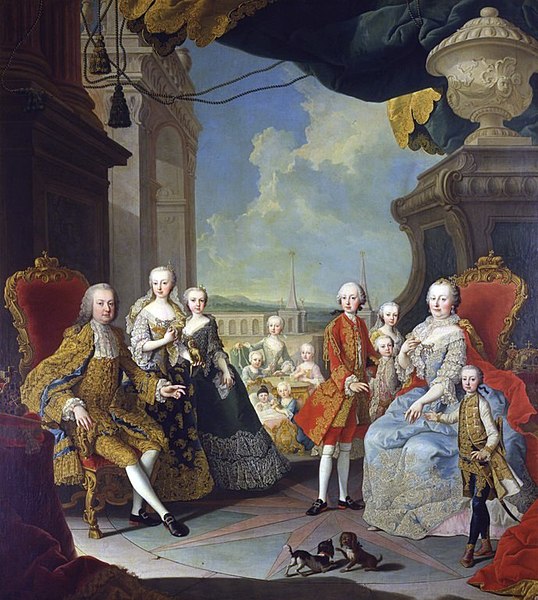
- Between the Austrian Succession War and the Seven Years' War, Maria Johanna, Maria Josepha, Maria Carolina (the third), Ferdinand, and Maria Antonia were born. Maria Theresa, aged 39, gave birth to Maximilian Francis during the Seven Years' War. Maria Theresa said she would have fought if she hadn't been pregnant. Motherhood and war shaped this period of her life.
- Maria Theresa lost several children and close friends due to various causes. Four of her children died before adolescence: Maria Elisabeth at three from stomach pains, Maria Carolina shortly after her first birthday, Maria Carolina born breach in 1748, and Maria Josepha at twelve in 1762 from smallpox.
- Maria Theresa's mother, Empress Elisabeth Christine, and governess, Marie Karoline von Fuchs-Mollard, died between 1750 and 1754. Maria Christina in 1749, Joseph in 1757, Charles in 1761, Johanna in 1762, and Maria Theresa in 1767 all contracted smallpox.
- Maria Theresa escaped smallpox from her daughter-in-law, bringing relief. Her sixteen-year-old daughter Josepha died of smallpox in October 1767, a sorrow that tormented her for life. The losses, notably during the epidemic of 1767, prompted her to fund smallpox inoculation trials and insist on inoculating the imperial family.
- Maria Theresa married her older children after having her younger ones. She negotiated marriages while handling wars and state obligations. She used her children as dynastic means, sacrificing their happiness for the state. Despite being a loving but self-conscious mother, Maria Theresa believed in exercising power over her children regardless of age or rank, writing to them monthly.
- Maria Antonia, later Marie Antoinette, Maria Theresa's youngest daughter, married Louis, Dauphin of France, in Vienna by proxy in April 1770. Maria Antonia's education was neglected, so Maria Theresa taught her about Versailles and French. She frequently wrote to Maria Antonia, chastising her for lethargy and infertility.
- Maria Theresa criticised Marie Antoinette and her other children. Leopold's reserve, Maria Carolina's politics, Ferdinand's disorganisation, and Maria Amalia's terrible French and haughtiness bothered her. Maria Christina was the sole child saved from continual scolding, enjoying her mother's confidence despite having no children.
- At her death, Maria Theresa had only about two dozen grandchildren, despite her yearning for many. All of her grandchildren's eldest daughters were named after her except Princess Carolina of Parma, Maria Amalia's.
- After Emperor Francis's 1765 death, Maria Theresa grieved deeply. In grieving, she withdrew from public life and struggled with mental illness. Joseph, her firstborn, became the Holy Roman Emperor. Despite their love, Maria Theresa and Joseph had a complicated relationship with many ideological and psychological disputes. After Maria Theresa lost Haugwitz, Joseph took over the military.
- While less intellectual than Joseph, Maria Theresa had royal attributes that counsellors valued. Maria Theresa remained sovereign despite their conflicts and abdication threats. Joseph and Prince Kaunitz organised the First Partition of Poland despite Maria Theresa's fairness concerns. Austria took Galicia and Lodomeria. Following geographical changes, Austria acquired Bukovina from the Ottoman Empire and fought in the Bavarian Succession (1778), affecting finances.
- Maria Theresa's health suffered following 1767's smallpox. She became very ill in November 1780 from different diseases. She requested her last rites and died on 29 November 1780, surrounded by her children, despite her initial optimism. After her death, the House of Habsburg-Lorraine took over. Her long-standing foe, Frederick the Great, lauded her achievements. Joseph II succeeded Maria Theresa and made more revisions than her annual edicts.
- After Maria Theresa's death, Austria's rulership changed. While Joseph II's reforms changed the empire, Maria Theresa's rule was characterised by both successes and difficulties. She outperformed other Habsburg rulers during her 40-year reign. After extensive changes, she concentrated on Austria's institutions, establishing enlightened absolutism. Her Catholic-influenced policies disregarded Enlightenment ideas, although she valued public welfare.
Image Sources
- https://commons.wikimedia.org/wiki/File:Kaiserin_Maria_Theresia_(HRR).jpg
- https://commons.wikimedia.org/wiki/File:Growth_of_Habsburg_territories.jpg
- https://commons.wikimedia.org/wiki/File:Friedrich_der_Gro%C3%9Fe_-_Johann_Georg_Ziesenis_-_Google_Cultural_Institute_(cropped_2).jpg
- https://commons.wikimedia.org/wiki/File:Maria_Theresia_im_Kreise_ihrer_Familie.jpg
Frequently Asked Questions
- Who was Maria Theresa of Austria?
Maria Theresa (1717–1780) was the Archduchess of Austria, Queen of Hungary and Bohemia, and the only female ruler of the Habsburg dominions, ruling from 1740 until she died in 1780.
- What was Maria Theresa's significance as a ruler?
Maria Theresa was a highly influential ruler known for her significant reforms and efforts to modernise the Habsburg Empire. She strengthened the central administration, reorganised the military, and implemented economic reforms, making her one of the most influential monarchs of the 18th century.
- How did Maria Theresa come to power?
Maria Theresa ascended to the throne in 1740 after her father, Emperor Charles VI, died. Her succession was challenged by other European powers, leading to the War of the Austrian Succession.
